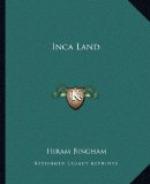Another striking fact brought out by Dr. Eaton is that some of the female skeletons represent individuals from the seacoast. This fits in with Calancha’s statement that Titu Cusi tempted the monks not only with beautiful women of the highlands, but also with those who came from the tribes of the Yungas, or “warm valleys.” The “warm valleys” may be those of the rubber country, but Sir Clements Markham thought the oases of the coast were meant.
Furthermore, as Mr. Safford has pointed out, among the artifacts discovered at Machu Picchu was a “snuffing tube” intended for use with the narcotic snuff which was employed by the priests and necromancers to induce a hypnotic state. This powder was made from the seeds of the tree which the Incas called huilca or uilca, which, as has been pointed out in Chapter xi, grows near these ruins. This seems to me to furnish additional evidence of the identity of Machu Picchu with Calancha’s “Vilcabamba.”
It cannot be denied that the ruins of Machu Picchu satisfy the requirements of “the largest city, in which was the University of Idolatry.” Until some one can find the ruins of another important place within three days’ journey of Pucyura which was an important religious center and whose skeletal remains are chiefly those of women, I am inclined to believe that this was the “Vilcabamba Viejo” of Calancha, just as Espiritu Pampa was the “Vilcabamba Viejo” of Ocampo.
In the interesting account of the last Incas purporting to be by Titu Cusi, but actually written in excellent Spanish by Friar Marcos, he says that his father, Manco, fleeing from Cuzco went first “to Vilcabamba, the head of all that province.”
In the “Anales del Peru” Montesinos says that Francisco Pizarro, thinking that the Inca Manco wished to make peace with him, tried to please the Inca by sending him a present of a very fine pony and a mulatto to take care of it. In place of rewarding the messenger, the Inca killed both man and beast. When Pizarro was informed of this, he took revenge on Manco by cruelly abusing the Inca’s favorite wife, and putting her to death. She begged of her attendants that “when she should be dead they would put her remains in a basket and let it float down the Yucay [or Urubamba] River, that the current might take it to her husband, the Inca.” She must have believed that at that time Manco was near this river. Machu Picchu is on its banks. Espiritu Pampa is not.
We have already seen how Manco finally established himself at Uiticos, where he restored in some degree the fortunes of his house. Surrounded by fertile valleys, not too far removed from the great highway which the Spaniards were obliged to use in passing from Lima to Cuzco, he could readily attack them. At Machu Picchu he would not have been so conveniently located for robbing the Spanish caravans nor for supplying his followers with arable lands.




